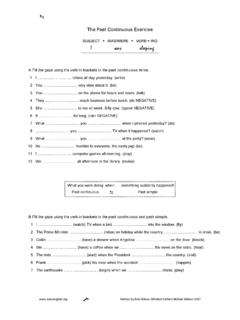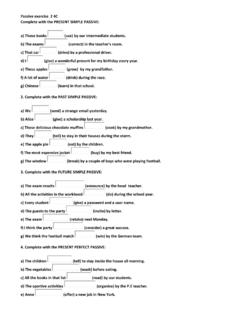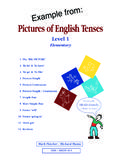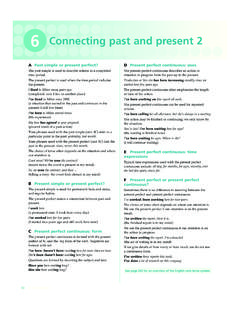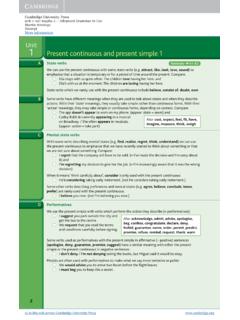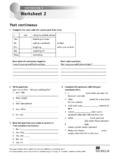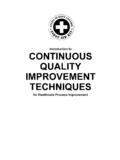Transcription of Exercise Treatment for Major Depression: Maintenance of ...
1 ExerciseTreatmentforMajorDepression:Main tenanceofTherapeuticBenefitat10 MonthsMICHAELBABYAK, PHD, , PHD,STEVEHERMAN, PHD,PARINDAKHATRI, PHD,MURALIDORAISWAMY,MD,KATHLEENMOORE, PHD, , PHD, , PHD, , MDObjective:Thepurposeofthisstudywastoas sessthestatusof156adultvolunteerswithmaj ordepressivedisorder(MDD)6monthsaftercom pletionofastudyinwhichtheywererandomlyas signedtoa4-monthcourseofaerobicexercise, sertralinetherapy, :Thepresenceandseverityofdepressionwerea ssessedbyclinicalinterviewusingtheDiagno sticInterviewScheduleandtheHamiltonRatin gScaleforDepression(HRSD) ,after4monthsoftreatment,and6monthsafter treatmentwasconcluded(ie,after10months). Results:After4monthspatientsinallthreegr oupsexhibitedsignificantimprovement;thep roportionofremittedpartici-pants(ie,thos ewhonolongermetdiagnosticcriteriaforMDDa ndhadanHRSD score!)
2 8) ,however,remittedsubjectsintheexercisegr ouphadsignificantlylowerrelapserates(p". 01) sownduringthefollow-upperiodwasassociate dwithareducedprobabilityofdepressiondiag nosisattheendofthatperiod(oddsratio" ,p".0009).Conclusions:Amongindividualswi thMDD,exercisetherapyisfeasibleandisasso ciatedwithsignificanttherapeuticbenefit, : depression , Exercise , "BeckDepressionInventory;DIS"DiagnosticI nterviewSchedule;DSM-IV"DiagnosticandSta tis-ticalManualofMentalDisorders,fourthe dition;HRSD"HamiltonRatingScaleforDepres sion;MDD"majordepressivedisorder;OR"odds ratio;SMILE"StandardMedicalInterventiona ndLong-TermEx-ercise(study).Aerobicexerc isehasbeenprescribedforthetreat-mentofaw iderangeofmedicaldisorders,includingcard iovasculardisease(1,2),hyperlipidemia(3) ,os-teoarthritis(4),fibromyalgia(5),andd iabetes(6).
3 Inaddition,exercisemayhaveanumberofpsych ologicalbenefits(7,8),andithasbeensugges tedasapotentialtreatmentforavarietyofpsy chiatricconditions,espe-ciallydepression (9,10).Epidemiologicalstudieshaveshownan inverserelationbetweenphysicalactivityan dmentalhealth(11,12).Ithasbeenshown,fore xample,thatphysicalactivityisinverselyre latedtodepressivesymptoms(12,13)andthati ndividualswhoincreasedtheiractivityovert imewereatnogreaterriskfordepressionthani ndividualswhohadbeenphysicallyactivealla long(14).Moreover, (15 638(2000)0033-3174/00/6205-0633 Copyright 2000bytheAmericanPsychosomaticSocietyMET HODSP articipantsParticipantswerevolunteersage d50yearsandolderwhometDSM-IVcriteriaforM DD(22)andscoredatleast13ontheHRSD(23) ,participantsalsometthefollowingcriteria :1)notcurrentlytakingantidepressantmedic ation;2)notcurrentlyusingothermedication sthatwouldprecludetheirbeingrandomlyassi gnedtoeithermedicationorexerciseconditio ns(eg,quinidineormetoprolol);3)nocurrent problemwithalcoholorsubstancedependence; 4)nomedicalcontraindicationstoexercise(e g,significantorthopedicproblemsorcardiop ulmonarydiseasethatwouldpreventregularae robicexercise).
4 5)noprimaryaxisIpsychiatricdiagnosisothe rthanmajordepression(eg,bipolardis-order orpsychosis);6)notimminentlysuicidal;7)n otcurrentlyinpsychotherapythatwasinitiat edwithinthepastyear;and8) (20). (24).SubjectswereconsideredtomeetDSM-IVc riteriaforMDDiftheyexhibitedeitherpersis tentdepressedmoodorlossofinterestorpleas ureplusthefollowingadditionalsymptoms:sl eepdistur-bance,weightlossorchangeinappe tite,psychomotorretardationoragitation,f atigueorlossofenergy,feelingsofworthless nessorexcessiveguilt,impairedcognitionor concentration,orrecurrentthoughtsofdeath , (23) , (25) ; ,participantswererandomlyassignedtooneof threetreatments:1)exercise2),medi-cation ,or3) (26), ,followedby30 (radialpulse) (Zoloft), (27).
5 Medicationmanagementwasprovidedbyastaffp sychiatrist,whometwitheachpatientatthebe ginningofthestudyandduringweeks2,6,10,14 , , usualcare guidelinesformedicationmanagement, ,HRSD,andBDIwerecon-ductedatbaseline,imm ediatelyafterthe4-monthtreatmentperiod,a nd6monthsaftertreatmentended(ie,10months afterstudyentry).Allevaluationswerecondu ctedinthehospitalclinic, (28).Subjectswereclassifiedasbeinginfull remissioniftheynolongermetcriteriaforMDD andhadanHRSD score! #6months(ie,atthe6-monthfollow-upvisit). Aclassificationofpartialrecoverywasusedt odesignatesubjectswhodidnotmeetcriteriaf orMDDbutstillexhibitedsignificantdepress ivesymptomsasreflectedbyanHRSD score#7but! ! ,andbeforethecurrentlevelofdepressionwas assessed,participantswereaskedaboutthena tureandextentofanytherapeuticactivityeng agedinduringthefollow-upperiod, :aerobicexercise,weighttraining, ,ifatall,theyengagedinthatparticulartype ofexerciseandtheusualduration(inminutes) (20).
6 Briefly,inten-tion-to-treatanalysesshowe dthatthegroupshadsim-ilarremissionratesw ithrespecttopresenceorabsenceofcurrentMD D(p".67) , , !8wasaddedtotheclassificationscheme,ther atesofremissionwereagaincomparableforthe threegroups(p".58).Finally, :633 638(2000)mentsforinitiallevelsofdepressi onweremade,thegroupsstilldidnotdifferonH RSD(p".39)orBDI(p".40) (6-MonthFollow-UpVisit)Follow-upassessme ntswereavailableon133( ) (oneineachgroup) ( Exercise :N"9,17%;medication:N"6,13%;com bination:N"8,15%;p".89). ,self-reporteddepressivesymptoms(ie,BDIs cores)didnotvaryamongpersonsinitiallyass ignedtotheexercise(mean$SE" $ ),medication( $ ),orcombinedexerciseandmedication( $ )groups(p".13).However,wheninter-viewerr atingsinwhichthepresenceofMDDwasdefineda sthepresenceofDSM-IVdiagnosisoranHRSD score#7wereused,itwasfoundthatpartici-pa ntsintheexercisegroupexhibitedlowerrates ofdepression(30%)thanparticipantsintheme dication(52%)andcombinedgroups(55%)(p".)
7 028). ,participantswerecategorizedasrecovered( noDSM-IVdiagnosisofMDDandanHRSD score!8for#6months),partiallyrecovered(n oDSM-IVdiagnosisofMDDandanHRSD score#7but!15),orrelapsed(presenceofDSM- IVdiagnosisofMDDregardlessofHRSD scoreoranHRSD score!15)(28).Toassesstherelationbetween treatmentandoutcomeclassification,apropo rtionaloddsregressionmodel,inwhichthethr ee-leveloutcome(fullrecovery,partialreco very,orrelapse)servedasthedependentvaria blewithbase-lineHRSD scorespecifiedasacovariate, ,withmedicationasthereferencegroup, ("2(2)" ,p".016).Specifi-cally,participantsinthe exercisegroupweremorelikelythanthoseinth emedicationgrouptobepar-tiallyorfullyrec overedatthe6-monthfollow-upvisit(OR" ,p".01).Incontrast,patientsreceivingcomb inationtherapywerenomorelikelytobecate-g orizedaspartiallyorfullyrecoveredthanwer epa-tientsinthemedicationgroup(OR" ,p".
8 57).Inaddition,only8%ofremittedpatientsi ntheexercisegrouphadrelapsed,comparedwit h38%inthemedi-cationgroupand31%inthecomb inationgroup( ). ,allpatientswereeducatedaboutMDDandweree ncouragedtocontinuewithsomeformoftreatme ntontheirown, ,48%ofparticipantsinthemedicationgroupin itiatedanexerciseprogramduringthe6-month follow-upperiod(p".17).Thegroupsdiffered significantlyinthenumberofsubjectsusinga ntidepressantmedication,with40%ofsubject sinthecombinationgroup,26%inthemedicatio ngroup,and7%intheexercisegroupreportinga ntide-pressantuseduringthe6-monthfollow- upperiod(p".001).Twenty-two(16%)ofthepar ticipantsenteredpsychotherapyattheendoft he4-monthintervention(medication:N"7;com bination:N"8; Exercise :N"7;p".
9 99). (6monthsaftertreatment)amongpatientswhow ereremitted(N"83)after4monthsoftreatment inExercise(N"25),Medication(N"29),andCom bination(N"29) , :633 638(2000)or1(nooryes),andexercisewasquan tifiedasthenumberofminutesperweekofaerob icexercise,scaledtoincrementsof1SD(about 50minutes).Age,gender, (seeTable1),adjustingfordepressionlevela tstudyentry,age,gender,andanti-depressan tmedicationuseduringthefollow-uppe-riod( p!.0009).HRSD scoresat4monthsalsowereinverselyrelatedt ominutesofexerciseperweek(% ,p!.001). (standardizedOR" ,p".002);however,minutesofexerciseperwee kremainedasignificantpredictorofdepressi vestatuswithlittlechangeintheeffectsize( standardizedOR" ,p".010).DISCUSSIONR esultsofthisrelativelylarge, (20), , , ,theoppositewasthecase, ,ifanything, antimedication sentimentamongsomestudyparticipants, , , , ,lessself-confirmingattributionforone Iwasdedi-catedandworkedhardwiththeexerci seprogram;itwasn teasy,butIbeatthisdepression, patientsmightincorporatethebeliefthat Itookanantidepressantandgotbetter.
10 Thepossibilitieshereareinteresting, , , ,however,thataftercontrollingforposttrea tmentde-pressionlevel, (no/yes) (&50min/wk) . :633 638(2000) :Feelinglessdepressedmaymakeitmorelikely thatpatientswillcontinuetoexercise, ,whichweintroducedinouroriginalreport(20 ),isthatthebenefitsoftheexerciseprogramm aybeattributable,atleastinpart, ,however,becausecontinuationofexercisedu ringthefollow-upperiodgenerallytookplace inanindi-vidual,ratherthanagroup, , (48%) ,only26%ofpatientsinthemedicationgroupch osetocontinuepharmacotherapy,andonly6% prescribed byaclinicianwillbeacceptedandcompliedwit htothesameextentaswhenitissoughtoutandad optedonone crossover ,thefindingthatself-reportedexercise,ind ependentoftheoriginaltreat-mentgroup, ,althoughweusedtheintention-to-treatprin cipleinconductingouranal-yses,15% , (medication,psychotherapy,andexercise).
